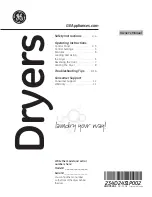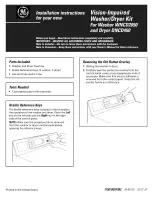
Fault, what to do?
en
37
Washable or water-soluble
coatings in the container or on
the door.
Detergent substances are deposited.
These coatings cannot usually be
removed with chemicals (appliance
cleaner, ...).
Change detergent brand.
Clean appliance mechanically.
If there is a “white coating” on the
container floor, the water softening
system has been set marginally.
Increase softening setting and change
detergent if required.
Salt dispenser cover
1R
not closed. Close salt dispenser cover correctly.
Only for glasses: Initial glass
corrosion – can only apparently be
wiped off.
See “Glass and utensil damage”
~
Page 15.
White, stubborn coatings;
limescale on the utensils,
container or door.
Detergent substances are deposited.
These coatings cannot usually be
removed with chemicals (appliance
cleaner, ...).
Change detergent brand.
Clean appliance mechanically.
Hardness range incorrectly set or
water hardness greater than 8.9
mmol/l.
Set water softening system according to
instructions for use or top up salt.
3in1 detergent or bio/eco detergent
not effective enough.
Set water softening system according to
instructions for use or use separate
detergents (proprietary detergent, salt,
rinse aid).
Underdosing of detergent.
Increase detergent dosage or change
detergent.
Too weak rinse programme selected.
Select a more intensive rinse programme.
Tea or lipstick residue on the
utensils.
Too low rinsing temperature.
Select programme with higher washing
temperature.
Too little or unsuitable detergent.
Use suitable detergent at correct dosage.
Utensils precleaned too intensely;
sensors therefore decide on weak
programme sequence. Stubborn
soiling cannot be completely
removed.
Do not prerinse utensils. Remove only large
food remnants.
Increase sensitivity of the sensors.
~
"Sensor setting" on page 27
Recommended programme Eco 50°
Coloured (blue, yellow, brown),
difficult to remove to non-
removable coatings in the
appliance or on stainless steel
utensils.
Film formation consisting of
ingredients from vegetables (e.g.
cabbage, celery, potatoes, noodles,
...) or the tap water (e.g. manganese).
Can be partly removed with machine cleaner
or by mechanical cleaning. Coatings are
harmless.
Film formation caused by metallic
components on silver or aluminium
utensils.
Can be partly removed with machine cleaner
or by mechanical cleaning.
Coloured (yellow, orange,
brown), easily removable
deposits inside the appliance
(mainly in the floor area).
Film formation consisting of
ingredients from food remnants and
substances from the tap water
(limescale), “soapy”.
Check function of the water softening
system (refill with salt) or, if using combined
detergents (tablets), activate water
softening system.
Discolouration of the plastic
parts inside the appliance.
Plastic parts inside the appliance
may become discoloured during the
service life of the dishwasher.
Discolouration is normal and will not impair
the function of the dishwasher.
Plastic parts discoloured.
Too low rinsing temperature.
Select programme with higher washing
temperature.
Utensils precleaned too intensely;
sensors therefore decide on weak
programme sequence. Stubborn
soiling cannot be completely
removed.
Do not prerinse utensils. Remove only large
food remnants.
Increase sensitivity of the sensors.
~
"Sensor setting" on page 27
Recommended programme Eco 50°
Fault
Cause
Remedial action








































